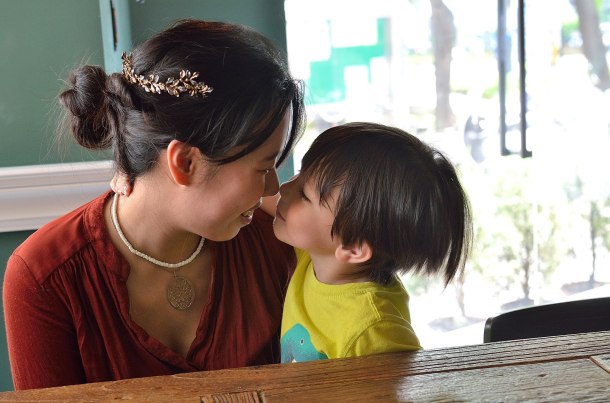
Attachment Theory was developed after Maria Montessori by Bowlby, beginning in 1969. So imagine my surprise to find Montessori speaking of Attachment in her 1946 London Lectures!
Little children between three and six years of age have a special psychology. They are full of love. They are only without love if they are ill treated. If they are badly treated their real nature is altered. Children are full of love and need to be loved in order to grow. All mothers naturally love their children and so the children get this love that they need.The love of the parents is the security of the young age. Their joy in life depends on the love for each other of all the people around them.
The sense of security that comes from having loving parents is necessary, too, for success in school; children of united families are more successful. Little children need to feel that their parents cannot live without them – that if they are not happy, their parents suffer. A psychologist gae a lecture here in London showing that harm was done to small children who had to be left behind by their parents when they went to work in the Colonies. He gave a striking example of a businessman who went to Australia, leaving his wife and little son in England. The child felt that he father was not so attached to them and then one day the mother told him that his father needed her and that she would have to join him. The child was broken-hearted. he had had the security of thinking that his mother loved him better than anyone else and then learnt that she, instead preferred the father. This meant the loss of all security for him.
(…)
By seven years of age, the child has a different psychology. He is no longer dependent on his parents’ love.
— Lecture 28 Religious Education, The 1946 London Lectures
I had previously written briefly on Montessori’s viewpoint on attachment here through the words of her student, Margaret Humfray. Half a year later, I wrote an essay that particularly focused on Attachment, as part of my Montessori training requirements, where I was not to quote Montessori. Here I had the opportunity to delve into the science of the theory of attachment. Where I found some surprising things. I think it is useful for parents to be aware of the findings of these attachment studies in the past half century, which I have summarized below.
- John Bowlby’s Attachment Theory (1969) was inspired by various animal studies : Harlow’s cloth mother/iron mother rhesus monkey study, and Konrad Lorenz’s discovery of imprinting in grey lag goslings.
- Bowlby’s timeline for attachment:
– Infants begin to exhibit preferential communication with primary caregivers around 5~7 months of age
– Attachment behaviours (clinging, upset when mother figure is absent…etc.) at around 9 months.
– Attachment behaviours peak at 12~16 months.
– Attachement formation has a sensitive period up to 2 or 3 years of age.
– Child becomes able to accomodate for other people’s needs around age 3. This is the next stage in the attachment relationship. Child exhibits less need for proximity and can now operate on more abstract needs such as affection, trust and approval. - Mary Ainsworth discovered that parenting style influences attachment style. It is important to note that infants, and later children, are shown to express different forms of attachment behaviours (or types) when presented with different adults in their life. Ex: the child may express type B when interacting with father, and type D to mother.
- Attachment style has ramifications for parent-child relationship into adulthood. Afterwards, other researchers found that:
– Attachment styles can continue to be propagated into the next generation.
– Children can change attachment category through life (Smith, Cowie & Blades, 2003)
– Mothers who experienced deprived parenting, but were highly reflective individuals, tended to raise securely attached infants (Fonagy etal., 1994) - Further into his career, Bowlby had modified his statement from ‘mothers’ to ‘primary caregivers’. Attachment does not have to be the mother, or female. Can be small constellation of primary caregivers.
- Later studies have also shown that there is no absolute prediction of the child’s ability to relate to others based on the attachment type they displayed in the lab during infancy. There are two ideas about how this may be: 1) that some children may be more resilient than others. And 2) that later trust relationships that were formed may also be influential to the child’s social outlook.
Keywords: Internal Working Model (Bowlby, 1969), Concept of Self (Bowlby, 1988), Secure Base, Strange Situation (Ainsworth), Parenting Styles (Ainsworth, 1978), 4 Types of Attachment (Ainsworth et al, 1978; Main, Solomon, 1990), Adult Attachment Interview (George, Kaplan, Main)


